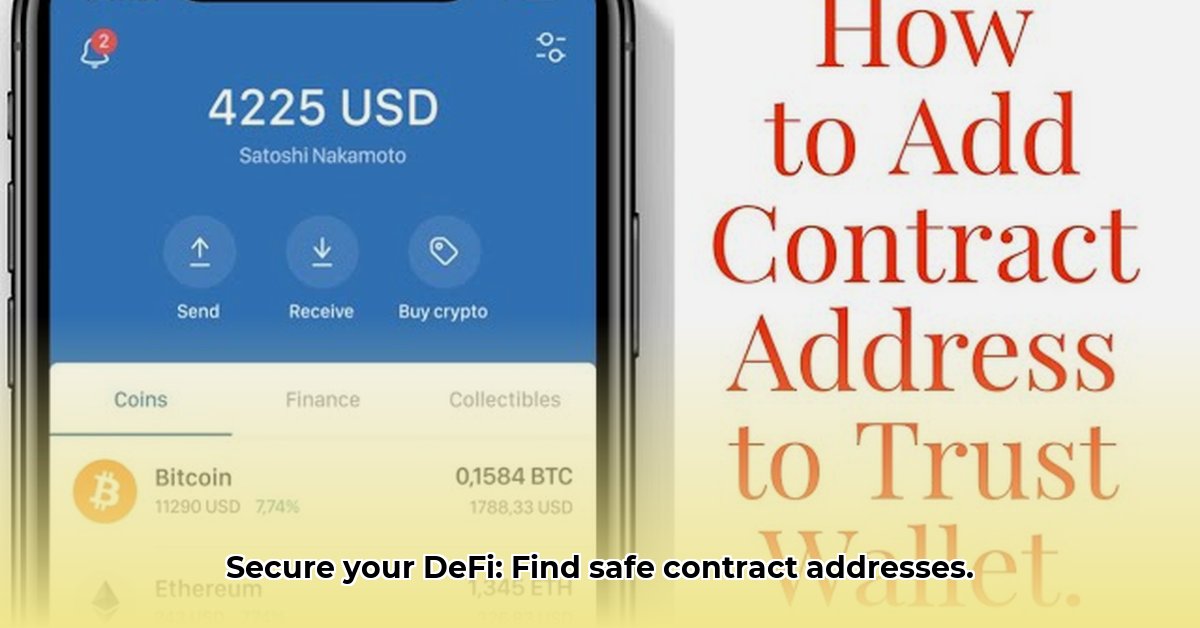
Understanding Contract Addresses in Decentralized Finance (DeFi)
Think of a contract address as the digital street address of a smart contract (a self-executing contract with the terms written into code) in the world of decentralized finance (DeFi). It's not your address, but the location of the digital agreement governing a specific cryptocurrency or token. This address dictates the rules and actions for that token. Accuracy is critical for safe DeFi transactions. Getting the correct address is paramount to avoid significant losses, and this guide will walk you through the process.
Finding the Right Contract Address
Locating the correct contract address is straightforward, employing several reliable methods:
Block Explorers: Websites like Etherscan (for Ethereum) and BscScan (for the BNB Chain) function as search engines for blockchain information. Searching the token's name usually reveals its contract address. This method provides direct verification.
Token Listing Sites: CoinGecko, CoinMarketCap, and similar sites list cryptocurrencies, often including their contract addresses. However, always verify the address on a block explorer for extra assurance.
Wallet Extensions: MetaMask and similar extensions sometimes automatically display the contract address when adding a new token. Despite convenience, always double-check with a block explorer or listing site.
Verifying the Contract Address: A Crucial Step
Before interacting with any token, always independently verify its contract address to avoid scams or interacting with fraudulent contracts. Here's how:
Cross-Referencing: Compare the address from multiple sources (block explorer, token listing site, your wallet). Discrepancies indicate a potential problem.
Checking the Source: Obtain the address from trusted, official sources (official project websites or reputable listing sites), avoiding random websites or social media.
Looking for Audits: Reputable projects undergo security audits; evidence of these audits adds a layer of trust.
Risk Assessment Matrix: Potential Hazards and Mitigation Strategies
Working with contract addresses carries inherent risks. Understanding these risks and mitigating strategies is crucial:
| Risk | Severity | Mitigation Strategy |
|---|---|---|
| Entering the Wrong Address | High | Triple-check the address from multiple sources before confirming any transaction. |
| Phishing and Scams | High | Use only official websites and links; be wary of unsolicited communications. |
| Smart Contract Bugs/Exploits | Medium | Research the contract's history and any known vulnerabilities. |
| Cross-Chain Transfer Issues | Medium | Use reputable bridges; test with small amounts first. |
Regulatory Considerations: Navigating the Legal Landscape
DeFi and crypto regulations are evolving. Laws vary by jurisdiction. Staying informed about local laws concerning cryptocurrency transactions is crucial for compliance.
Understanding Token Standards
Different blockchains use different token standards (e.g., ERC-20 on Ethereum, BEP-20 on BNB Chain). Understanding these standards helps you find the correct address for the appropriate network. Cross-chain transfers require extra caution and reliable bridges.
A Step-by-Step Guide to Verifying Contract Addresses Across Blockchains
This process is similar across blockchains, emphasizing verification from trustworthy sources:
Identify Token and Blockchain: Determine the token and its host blockchain (e.g., Ethereum, Binance Smart Chain).
Locate Reputable Sources: Find the token's official website or documentation and reputable exchanges listing the token.
Cross-Reference the Address: Compare the address across multiple sources. Discrepancies are major red flags.
Examine the Smart Contract (Advanced): Analyze the smart contract code (for advanced users with programming and blockchain expertise).
Use Block Explorers: Etherscan, BscScan, and similar tools verify the token's existence and transaction history.
Isn't it crucial to be absolutely certain before interacting with a token contract?
Mitigating Risks: Safe DeFi Practices
The decentralized nature of DeFi increases scam risks. Minimize risks by:
- Diversifying your portfolio: Spread your investments across multiple tokens and projects.
- Starting small: Begin with small investments to gauge the project before committing significant capital.
- Staying informed: The DeFi space changes rapidly; continuous learning is essential.
Example: Verifying an Ethereum Token
To verify an Ethereum token's address, visit the token's official website and cross-reference the provided address with Etherscan (https://etherscan.io/). Verify its existence and view transaction history.
Remember, due diligence is paramount in DeFi. This guide provides a foundation; continuous learning ensures safe and effective navigation of the DeFi landscape.